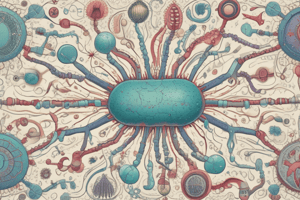Podcast
Questions and Answers
What is the nature of plasmids?
What is the nature of plasmids?
- Circular single-stranded extrachromosomal DNA molecules
- Circular double-stranded extrachromosomal DNA molecules (correct)
- Linear double-stranded extrachromosomal DNA molecules
- Linear single-stranded extrachromosomal DNA molecules
What are episomes?
What are episomes?
- Plasmids integrated with bacterial chromosomes (correct)
- Linear single-stranded extrachromosomal DNA molecules
- Transmissible plasmids
- Nontransmissible plasmids
What are the two types of transmissible plasmids based on their transmissibility?
What are the two types of transmissible plasmids based on their transmissibility?
- Large and small
- Conjugative and nonconjugative (correct)
- High copy number and low copy number
- Circular and linear
What are the two types of transmissible plasmids based on their transmissibility?
What are the two types of transmissible plasmids based on their transmissibility?
What is the characteristic of nontransmissible plasmids?
What is the characteristic of nontransmissible plasmids?
What is the function of plasmids in bacterial cells?
What is the function of plasmids in bacterial cells?
What are episomes in the context of plasmids?
What are episomes in the context of plasmids?
What are the characteristics of nontransmissible plasmids?
What are the characteristics of nontransmissible plasmids?
What is the significance of the transmissible (conjugative) plasmids?
What is the significance of the transmissible (conjugative) plasmids?
Flashcards are hidden until you start studying





